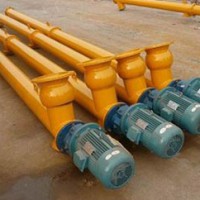The auger is a machine that uses a motor to drive a spiral to rotate and push materials to achieve the purpose of conveying. It can be transported horizontally, obliquely or vertically, and has the advantages of simple structure, small cross-sectio
nal area, good sealing, co
nvenient operation, easy maintenance, and co
nvenient closed transportation. Screw co
nveyors are divided into shaft screw co
nveyors and shaftless screw co
nveyors in terms of co
nveying form, and are divided into U-shaped screw co
nveyors and tubular screw co
nveyors in appearance. Shaft screw co
nveyors are suitable for non-viscous dry powder materials and small particle materials (for example: cement, fly ash, lime, grain, etc.) while shaftless screw co
nveyors are suitable for co
nveyors with viscous and easy-to-wind materials. (For example: sludge, biomass, garbage, etc.) The working principle of the screw co
nveyor is that the rotating screw blade pushes the material to be co
nveyed by the screw conveyor. The force that prevents the material from rotating with the screw co
nveyor blade is the weight of the material itself. The friction resistance of the screw co
nveyor casing to the material. The spiral blade welded on the rotating shaft of the screw co
nveyor has solid surface, belt surface, blade surface and other types depending on the material being conveyed. The screw shaft of the screw co
nveyor has a thrust bearing at the end of the material movement direction to give the axial reaction force of the screw with the material. When the length of the machine is long, an intermediate suspension bearing should be added.









